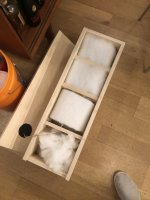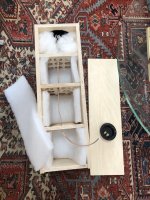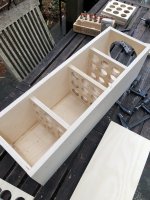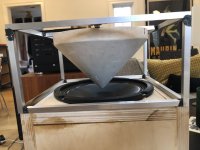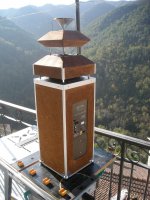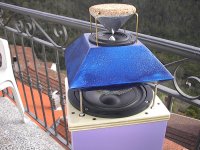Hi. I CAN HAZ CRITIQ PLZ?
I have a large vaulted room. 19x40 with a vaulted ceiling reaching 15' at the peak. Due to WAF, I'm working with specific locations in the room where speakers can go. I have some Klipsch Cornwall I's in my room corners. My personal listening habits have me all over the room and I really don't spend much time in my Cornwalls' sweet spot. Omnidirectional speakers (or more accurately, radial speakers) are said to have a very large sweet spot. There are not very many available and they tend to be very expensive, especially for the larger models that would go well in my large space. So, DIY it is. I decided to build a very basic/inexpensive pair of omnis to get a little bit of an idea of how omnis could work in the room. I mounted Visaton BG20 full range drivers on top of a 30 liter sealed baltic birch box with 45 deg dispersion cones above. The driver spec sheet said fc 82 Hz QTC 0,96 so I figured I'd fill in below 80 Hz with My Hsu Subwoofer. I chose a sealed design because the ported spec is 50 liters.
Well, they sound a bit like toy speakers. Really very small. There seems to be a distinct lack of low-mid frequencies before the sub fills in. At the same time, I can tell that they have promise. If I can find the right driver(s) and the right cabinet construction, omnis really could work in the space. See pics. They're far away from the walls and have two large sweet areas on either side of the pair, which is perfect for the room.
I'm not sure how well executed these speakers are. They're my first. I'm wondering if the lack of low-mid frequencies comes from over-bracing them? Maybe the holes I put in the braces weren't large enough? Maybe I over-stuffed with sound attenuation material? See pics.
I think some marginal improvements might be had by rounding off the edges and sinking the speaker flange to make the top of the cone flush with the top of the cabinet. I could also do the same with the support rails along the edges of the cabinet top -- sink them down to make them flush as well.
Anyhoo, I need to decide whether to proceed with this experiment by getting some better drivers, and building a speaker that is more suited to the room. I'm assuming that would be a larger one. I like the idea of a full range speaker with a horn coming out the bottom. It seems very elegant, but I'm not opposed to a 2-way design with, say a tweeter on top of the cone with another mini cone on top of that like Morrison Audio or Duevel speakers and I could do an active crossover on my MiniDSP 2x4HD. I could even bi amp them to add to the fun.
So, what do you think? Some Lii Audio Drivers? Fostex? Lowther? A Voigt pipe of some kind? A folded horn? A straight one? Forget the whole thing and just use my Cornwalls?
Thanks for your critique!
In case you are wondering, the pig is a javelina.
I have a large vaulted room. 19x40 with a vaulted ceiling reaching 15' at the peak. Due to WAF, I'm working with specific locations in the room where speakers can go. I have some Klipsch Cornwall I's in my room corners. My personal listening habits have me all over the room and I really don't spend much time in my Cornwalls' sweet spot. Omnidirectional speakers (or more accurately, radial speakers) are said to have a very large sweet spot. There are not very many available and they tend to be very expensive, especially for the larger models that would go well in my large space. So, DIY it is. I decided to build a very basic/inexpensive pair of omnis to get a little bit of an idea of how omnis could work in the room. I mounted Visaton BG20 full range drivers on top of a 30 liter sealed baltic birch box with 45 deg dispersion cones above. The driver spec sheet said fc 82 Hz QTC 0,96 so I figured I'd fill in below 80 Hz with My Hsu Subwoofer. I chose a sealed design because the ported spec is 50 liters.
Well, they sound a bit like toy speakers. Really very small. There seems to be a distinct lack of low-mid frequencies before the sub fills in. At the same time, I can tell that they have promise. If I can find the right driver(s) and the right cabinet construction, omnis really could work in the space. See pics. They're far away from the walls and have two large sweet areas on either side of the pair, which is perfect for the room.
I'm not sure how well executed these speakers are. They're my first. I'm wondering if the lack of low-mid frequencies comes from over-bracing them? Maybe the holes I put in the braces weren't large enough? Maybe I over-stuffed with sound attenuation material? See pics.
I think some marginal improvements might be had by rounding off the edges and sinking the speaker flange to make the top of the cone flush with the top of the cabinet. I could also do the same with the support rails along the edges of the cabinet top -- sink them down to make them flush as well.
Anyhoo, I need to decide whether to proceed with this experiment by getting some better drivers, and building a speaker that is more suited to the room. I'm assuming that would be a larger one. I like the idea of a full range speaker with a horn coming out the bottom. It seems very elegant, but I'm not opposed to a 2-way design with, say a tweeter on top of the cone with another mini cone on top of that like Morrison Audio or Duevel speakers and I could do an active crossover on my MiniDSP 2x4HD. I could even bi amp them to add to the fun.
So, what do you think? Some Lii Audio Drivers? Fostex? Lowther? A Voigt pipe of some kind? A folded horn? A straight one? Forget the whole thing and just use my Cornwalls?
Thanks for your critique!
In case you are wondering, the pig is a javelina.
Attachments
I'm wondering if the lack of low-mid frequencies comes from over-bracing them? Maybe the holes I put in the braces weren't large enough? Maybe I over-stuffed with sound attenuation material? See pics.
I think some marginal improvements might be had by rounding off the edges and sinking the speaker flange to make the top of the cone flush with the top of the cabinet. I could also do the same with the support rails along the edges of the cabinet top -- sink them down to make them flush as well.
Most of the things you describe as possible changes to the current enclosure would make minor differences at best. Over bracing isn't really possible, as long as you leave enough net volume in the enclosure. The holes in your braces look like their total area is similar to the driver, so that shouldn't be a problem. Stuffing doesn't look excessive. Flush mounting and rounding are going to affect higher frequencies, so not relevant to your biggest complaint.
In my experience, without some kind of EQ/crossover it's tough to get adequate bass from sealed enclosures with many 8-inch drivers on their own (unless you're dealing with something designed as a subwoofer). Two 8's are better, but still not great. The one you're dealing with looks like it has some inherent roll-off at lower frequencies and a pretty significant boost at higher frequencies.
Depending on where you want your sub to come in, a single 8 may be OK as a basic design goal though.
One thing you didn't suggest is equalizing the current setup with the miniDSP. Your driver doesn't have much Xmax available, so it'll run out of gas at higher levels, but equalizing them should make them tolerable so you can get a better feel for the dispersion and general performance of the idea.
1. You might be right with creating Helmholtz resonators with your bracing. cut out the middle part and just leave the frame.
2. Without a proper x-over there will be strong interferences with the sub. with the high Q-factor a 2nd order high-pass of 80Hz with Q=0.5 will create a Linkwitz Riley 4th order, you will need the same for the sub as lowpass.
3. You also need a L|C|R (all parallel) to suppress frequencies between 1000Hz and maybe 5000Hz depending on the quality of your reflector.
Since you are not yet familiar designing Xovers, try first to measure impedances and when you have a mike also SPL. Maybe someone can help from the group
2. Without a proper x-over there will be strong interferences with the sub. with the high Q-factor a 2nd order high-pass of 80Hz with Q=0.5 will create a Linkwitz Riley 4th order, you will need the same for the sub as lowpass.
3. You also need a L|C|R (all parallel) to suppress frequencies between 1000Hz and maybe 5000Hz depending on the quality of your reflector.
Since you are not yet familiar designing Xovers, try first to measure impedances and when you have a mike also SPL. Maybe someone can help from the group
Last edited:
Depending on where you want your sub to come in, a single 8 may be OK as a basic design goal though.
One thing you didn't suggest is equalizing the current setup with the miniDSP. Your driver doesn't have much Xmax available, so it'll run out of gas at higher levels, but equalizing them should make them tolerable so you can get a better feel for the dispersion and general performance of the idea.
Thanks! You mention that a single 8 may be OK. Would a larger full range be better or are you suggesting that it'd be better not to use a full range speaker?
And yes. As soon as I figure out MiniDSP/REW I'll EQ them. I'm pretty adept at technology and I'm finding it very difficult to use.
1. You might be right with creating Helmholtz resonators with your bracing. cut out the middle part and just leave the frame.
2. Without a proper x-over there will be strong interferences with the sub. with the high Q-factor a 2nd order high-pass of 80Hz with Q=0.5 will create a Linkwitz Riley 4th order, you will need the same for the sub as lowpass.
3. You also need a L|C|R (all parallel) to suppress frequencies between 1000Hz and maybe 5000Hz depending on the quality of your reflector.
Since you are not yet familiar designing Xovers, try first to measure impedances and when you have a mike also SPL. Maybe someone can help from the group
1. I sort of had that in the back of my mind. I'd have to cut open the speakers (should'a screwed in a panel instead of gluing them all!).
2. I'll need to study up on the terms that you are using, but there seem to be a nice trail of clues there! I'm uploading the manual for my Hsu Research VTF-2 MK4 sub if anyone is interested in some bedtime reading!
3. I'm guessing that's something I might be able to do via EQ on my MiniDSP...
Thanks!
Attachments
Another parameter that can be changed is the shape of the dispersion cone. I chose a 45 Degree cone for ease of fabrication and I thought that the reflections would be more versatile -- to work when people are standing or sitting. The other designs I have seen are parabolic and hemispheric. They're a bit difficult to fabricate, but I could do them and swap them out. I also matched the diameter of the driver, which I'm not sure about either. There are so many parameters!!
Cool project! Removing the foam ring and make a flush top will make the sound much smoother in the important 2-5kHz range. It will be easy to see the improvements in REW etc. I think your going to see 2-4db ripples with your current design so a flush driver would really be worth it!
This is probably why it sounds thin. Dispersion is still straight up. You need a wave guide. Basically a circular exponential horn. If you made it out of heavy cardboard you could compress it incrementally til you find best response. Then use that as a template.🙂Another parameter that can be changed is the shape of the dispersion cone.
You mention that a single 8 may be OK. Would a larger full range be better or are you suggesting that it'd be better not to use a full range speaker?.
My comment about the single 8" was primarily about the sealed enclosure, no equalization, no sub, and wanting higher frequency coverage. A ported enclosure, transmission line, etc. would help to boost the bottom end and should reduce excursion requirements, but adds design complexity and the potential for poor sound if not done well. Obviously a subwoofer changes the demands made on the primary speakers also.
Full-range drivers can be a little tricky. Most of the ones I've tried have needed some EQ help to sound right. I think sticking to the minimum size you can get away with is advisable. In an omnidirectional design, even more so. Larger full-range drivers of good quality tend to be pretty expensive also.
A lot of it comes down to exactly what you want your speaker to do and how particular you are about various performance aspects. If you only need to get down to 80-100 Hz with the primary speaker and you aren't looking for ear shattering output, that makes things a lot easier. Handing off to another speaker that is designed for bass obviously adds its own complications, but gives you a lot more flexibility on the "full range" driver.
All of which gets us back to EQing the current speakers. If you do that and they make you reasonably happy, it gives you a pretty good starting point for refinement. As you said earlier, there are a zillion decisions and changes that can be made, but without some measurements and basic frequency adjustments to what you have done already, it's difficult to decide what's useful.
Another parameter that can be changed is the shape of the dispersion cone. I chose
a 45 Degree cone for ease of fabrication and I thought that the reflections would be more versatile
What are the cones made of? They should be hard, smooth, and reflective.
This is probably why it sounds thin. Dispersion is still straight up. You need a wave guide. Basically a circular exponential horn. If you made it out of heavy cardboard you could compress it incrementally til you find best response. Then use that as a template.🙂
Wouldn't a parabolic shaped cone basically create a circular exponential horn?
Like this:
venus high end loudspeaker
Cool project! Removing the foam ring and make a flush top will make the sound much smoother in the important 2-5kHz range. It will be easy to see the improvements in REW etc. I think your going to see 2-4db ripples with your current design so a flush driver would really be worth it!
If you insist! I'll take some frequency response readings, make that change and then take them again. Fun experiment! I'll post the results.
What are the cones made of? They should be hard, smooth, and reflective.
A core of wood disks with Bondo smoothed over it and sanded down by hand. Not pretty, but very hard and heavy.
My comment about the single 8" was primarily about the sealed enclosure, no equalization, no sub, and wanting higher frequency coverage. A ported enclosure, transmission line, etc. would help to boost the bottom end and should reduce excursion requirements, but adds design complexity and the potential for poor sound if not done well. Obviously a subwoofer changes the demands made on the primary speakers also.
Full-range drivers can be a little tricky. Most of the ones I've tried have needed some EQ help to sound right. I think sticking to the minimum size you can get away with is advisable. In an omnidirectional design, even more so. Larger full-range drivers of good quality tend to be pretty expensive also.
A lot of it comes down to exactly what you want your speaker to do and how particular you are about various performance aspects. If you only need to get down to 80-100 Hz with the primary speaker and you aren't looking for ear shattering output, that makes things a lot easier. Handing off to another speaker that is designed for bass obviously adds its own complications, but gives you a lot more flexibility on the "full range" driver.
All of which gets us back to EQing the current speakers. If you do that and they make you reasonably happy, it gives you a pretty good starting point for refinement. As you said earlier, there are a zillion decisions and changes that can be made, but without some measurements and basic frequency adjustments to what you have done already, it's difficult to decide what's useful.
It seems like the easiest course of action would be to use a sub to pick up the 80-100Hz and below as you suggest. As far as driver budget for a "final version" I'd probably be able to do as much as $1,000 or possibly more if there were some compelling evidence that I could dispose of my Cornwalls. I basically have to get rid of the Hsu Sub, so it's just an experimenter right now. It never really passed WAF. I was thinking of building something big that could slide under our credenza -- perhaps even taking the Hsu apart and rebuilding it with dimensions that would allow it to be hidden away -- but I bet that could go very wrong... Subwoofer changeout will occur after everything else is sorted...
A core of wood disks with Bondo smoothed over it and sanded down by hand.
Not pretty, but very hard and heavy.
Consider a hard, smooth finish coat on the surface, which will increase the midband reflectivity.
Maybe polyurethane.
Last edited:
Beautiful. Old schoolhouse?
Bound to be harsh due to absence of stuffing in room.
Is this another thread where OP has vague disappointment with some vague aspect of sound? And members rush in to fix a problem before defining it?
"Sweet spot" - deserves some thought here. Ordinarily means people in different locations can hear the Amsterdam Concertgebouw players in their usual seats* on the west wall of your room.
So how does that (a beer party for the local HiFi club) translate into your enjoyment of ambient sound while figuring out some legal issue at your desk? I have a second location I use in my listening room and the bass is way, way boomier there and the top tweets less: so I just say to myself, "gosh, great sound but the bass is boomy...".
B.
*if you know what the non-proscenium Concertgebouw hall looks like.... I only mention this goal because it is commonly held even if ridiculous the minute you think about it
Bound to be harsh due to absence of stuffing in room.
Is this another thread where OP has vague disappointment with some vague aspect of sound? And members rush in to fix a problem before defining it?
"Sweet spot" - deserves some thought here. Ordinarily means people in different locations can hear the Amsterdam Concertgebouw players in their usual seats* on the west wall of your room.
So how does that (a beer party for the local HiFi club) translate into your enjoyment of ambient sound while figuring out some legal issue at your desk? I have a second location I use in my listening room and the bass is way, way boomier there and the top tweets less: so I just say to myself, "gosh, great sound but the bass is boomy...".
B.
*if you know what the non-proscenium Concertgebouw hall looks like.... I only mention this goal because it is commonly held even if ridiculous the minute you think about it
Last edited:
Beautiful. Old schoolhouse?
Thanks! Church.
Bound to be harsh due to absence of stuffing in room.
Is this another thread where OP has vague disappointment with some vague aspect of sound? And members rush in to fix a problem before defining it?
"Sweet spot" - deserves some thought here. Ordinarily means people in different locations can hear the Amsterdam Concertgebouw players in their usual seats* on the west wall of your room.
So how does that (a beer party for the local HiFi club) translate into your enjoyment of ambient sound while figuring out some legal issue at your desk? I have a second location I use in my listening room and the bass is way, way boomier there and the top tweets less: so I just say to myself, "gosh, great sound but the bass is boomy...".
B.
*if you know what the non-proscenium Concertgebouw hall looks like.... I only mention this goal because it is commonly held even if ridiculous the minute you think about it
I'm happy to tell you more 🙂
When I'm sitting on the middle seat of my couch the Cornwalls sound really excellent (when they're not being shouty and sibilant as they are on certain tracks). Once I move away from the sweet spot, it's okay. They just seem a bit directional to me. I suspect it's the fact that the tweeter and squawker are horns and that's how they work. I need horns because I need to locate speakers in the room corners. The other location we could probably do is basically on either side of the credenza/couch setup in the middle of the room. From what I gather, that would allow an omnidirectional type of speaker, which reportedly have a very large sweet area on either side of the pair. They're supposedly a bit oddball and imaging might not be as good, but that tradeoff seems worth it to me as I am not that discerning.
I mounted Visaton BG20 full range drivers on top of a 30 liter sealed baltic birch box with 45 deg dispersion cones above. The driver spec sheet said fc 82 Hz QTC 0,96 so I figured I'd fill in below 80 Hz with My Hsu Subwoofer. I chose a sealed design because the ported spec is 50 liters.
From looking at it, i would expect the issue could be th eshape of the deflector. The ones i have seen have tyically been curved, and often with a helper tweeter.
from over-bracing them? Maybe the holes I put in the braces weren't large enough? Maybe I over-stuffed with sound attenuation material
Very unlikely. The braces do run the wrong way for best effect, with sealed you need to really, really stuff it to run into issues, and given the high driver Q and small box you could likely use as much as possible.
I need to decide whether to proceed with this experiment by getting some better drivers
The BG20 is a cheap driver, but i have not heard it. A SEAS FA22 would largely play the same role, but first i would play with a tweeter and the shape of the reflector (in whichever order tweaks your fancy).
Or the Linkwitx Pluto for inspiration.
and building a speaker that is more suited to the room. I'm assuming that would be a larger one.
Not necessarily. Big for bass. Relatively.
I am currently using quite small speaker sin a quite large room and am not suffering.
Some Lii Audio Drivers? Fostex? Lowther? A Voigt pipe of some kind? A folded horn? A straight one? Forget the whole thing and just use my Cornwalls?
The first are getting a lot of comments recently, haven’t heard them on paper they don’t look so good. The Fostex FFxx5wk drivers might suit (FF165wk in your box, probably tall enuff to be made into an ML-TL). End loaded is not optimal but it is what we are workign with. Lowther are i whole differen tprice league. A smaller Mark Audio like the CHN-110 (keeping the budget down), A10.3/p, A11ms, P11 would ikely get better top — strike the suggestion of the A10p.likely need something with a hotter top end.
Cornwalls stock i have found poor, the Crites XO has the potential to significantly improve them, but triamping with good settings on the time delay woud make a huge difference. The woofer, mid and tweeter on this are in hugely different physical places which is a serious issue with a passive XO. They will not have the omni nature you seem to be looking for.
dave
- Home
- Loudspeakers
- Planars & Exotics
- Please Critique My DIY Omnis!


